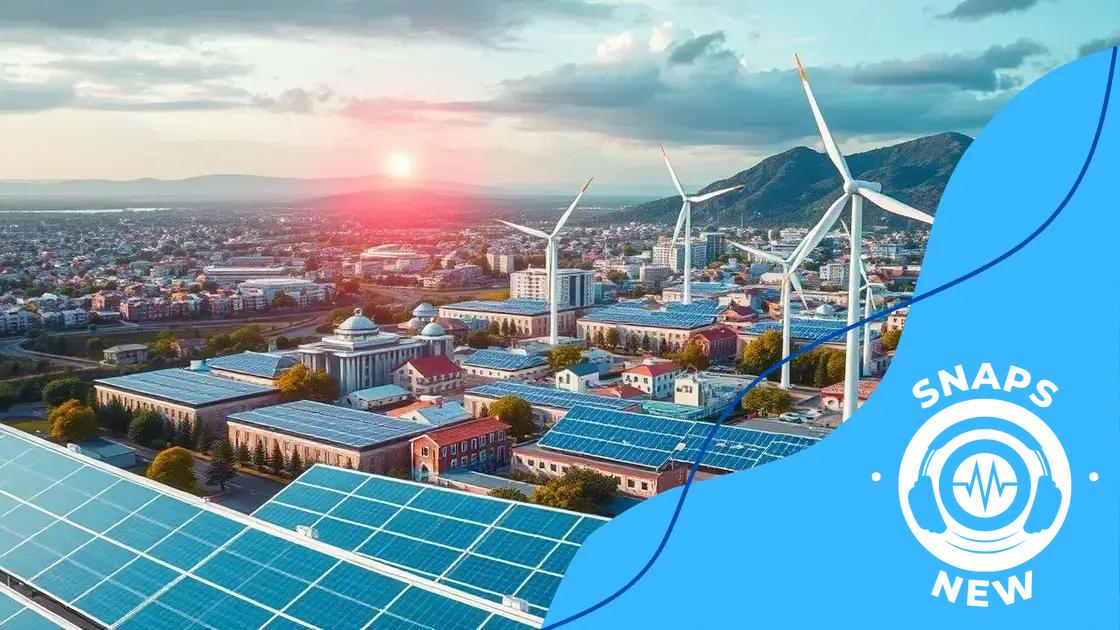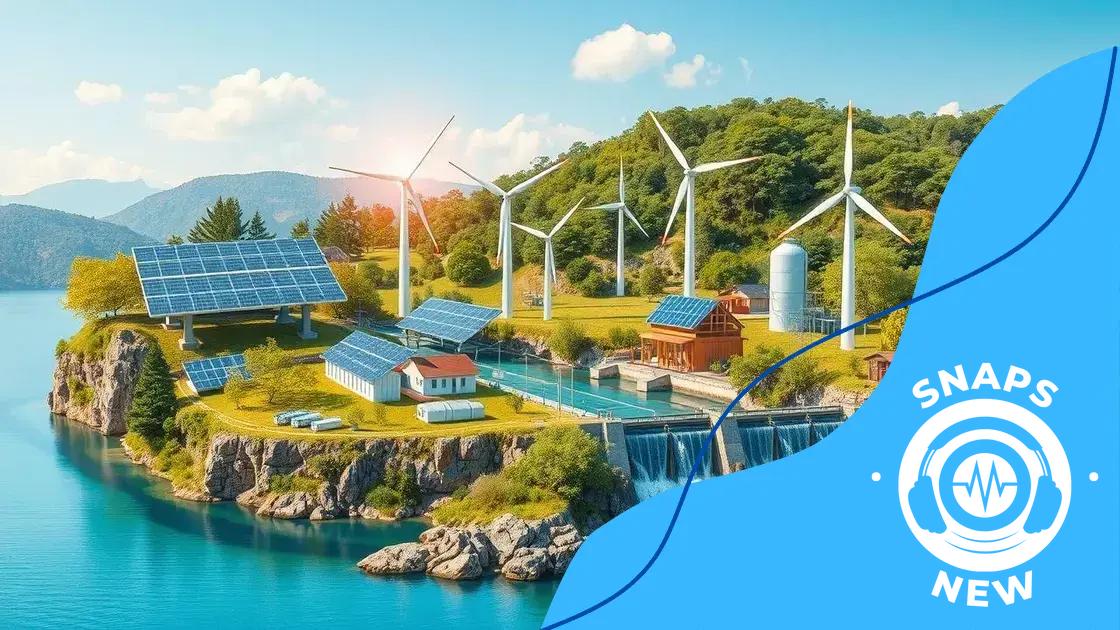Climate change and tech solutions: innovating for the future

Tech-driven climate action leverages innovative technologies and collaboration among stakeholders to effectively mitigate climate change impacts and promote sustainable practices in urban environments.
Climate change and tech solutions are reshaping our approach to environmental challenges. But have you considered how technology can be a game-changer in this scenario? In this article, we’ll delve into the exciting possibilities that emerge when innovation meets sustainability.
Understanding climate change impacts
Understanding the impacts of climate change is essential for grasping the full extent of our environmental challenges. It affects everything from weather patterns to wildlife habitats, and the urgency to address these changes cannot be overstated.
As we dive deeper, we uncover how rising temperatures lead to extreme weather events. These changes can disrupt ecosystems and human life alike. For instance, flooding can become more frequent, while droughts may intensify in other regions.
Key Impacts of Climate Change
Let’s take a moment to explore some critical impacts:
- Increased global temperatures: Average temperatures are rising due to greenhouse gas emissions.
- Melting ice caps: Glaciers and Arctic ice are shrinking, raising sea levels.
- Ocean acidification: Increased carbon dioxide levels harm marine life and ecosystems.
- Loss of biodiversity: Many species are threatened or endangered due to shifting habitats.
Moreover, the human experience is also changing. Agriculture is experiencing challenges as weather patterns make it harder to grow crops consistently. Poor air quality is another concern linked to climate change, leading to public health risks. Communities need to be aware of these risks to adapt effectively.
Addressing the roots of these impacts can seem daunting, but understanding them prepares us for action. By learning about the effects of climate change, we open the door to discovering innovative solutions that technology can offer.
Innovative technologies to fight climate change
Innovative technologies play a crucial role in combating climate change. These advancements help reduce emissions, improve efficiency, and create sustainable practices. From renewable energy to smart agriculture, the landscape of solutions is evolving rapidly.
One major area of innovation is renewable energy. Solar and wind power are leading the charge in reducing reliance on fossil fuels. Advancements in energy storage technologies, such as batteries, enable us to harness this energy more effectively.
Key Technologies in Renewable Energy
Several promising technologies are reshaping our energy landscape:
- Solar panels: More efficient designs are emerging, maximizing power generation.
- Wind turbines: Turbines are becoming larger and more efficient, harnessing wind energy better.
- Tidal energy: Innovative systems are being developed to capture energy from tides and currents.
- Geothermal systems: These systems use the earth’s heat to provide sustainable energy.
In addition to energy, smart technologies are improving resource management. For example, precision agriculture uses data analytics to optimize crop yields while minimizing environmental impact. This method ensures that water and fertilizers are used efficiently, resulting in less waste.
Furthermore, carbon capture technology is gaining attention. This innovative approach involves capturing carbon dioxide emissions from industrial sources before they reach the atmosphere. The captured CO2 can then be stored or reused in different applications, reducing its impact on the environment.
Lastly, the role of sustainable transportation is crucial. Electric vehicles (EVs) are leading the way in reducing greenhouse gas emissions from the transportation sector. Advances in battery technology are making these vehicles more accessible and efficient.
The role of renewable energy solutions

The role of renewable energy solutions is vital in the fight against climate change. These solutions help reduce greenhouse gas emissions and provide sustainable energy for future generations. As we transition from fossil fuels, renewable sources are becoming increasingly essential to global energy needs.
Solar and wind energy are leading the way. Solar power harnesses energy from the sun using photovoltaic cells. This technology has advanced, making solar panels more efficient and affordable. Meanwhile, wind energy captures the power of the wind using turbines, which can generate electricity without harmful emissions.
Benefits of Renewable Energy
Renewable energy solutions offer several important benefits:
- Environmental impact: They produce little to no greenhouse gases, helping mitigate climate change.
- Sustainability: Renewable resources like sunlight and wind are abundant and will not run out.
- Job creation: The renewable energy sector provides numerous jobs, from manufacturing to installation.
- Energy independence: Using local renewable resources reduces dependence on imported fuels.
Beyond solar and wind, other renewable sources like hydro and geothermal energy are also making significant contributions. Hydroelectric power utilizes flowing water to generate electricity, while geothermal energy taps into the Earth’s heat for a consistent energy source.
Communities are increasingly adopting these solutions, not just at the utility scale but also at the individual level. Homeowners are installing solar panels to power their homes, reducing energy costs and their carbon footprint. As these technologies advance, energy storage solutions like batteries are improving, allowing for better management of energy usage.
The role of renewable energy is not just about creating power; it’s also about creating a sustainable future. By investing in these technologies, we can protect our environment while ensuring a reliable energy supply for all.
Smart technologies for sustainable cities
Smart technologies are transforming our cities into more sustainable environments. These technologies enhance urban living by improving resource management and reducing environmental impacts. As cities grow, smart solutions become essential for ensuring a better quality of life.
One key area of focus is intelligent energy management. Smart grids allow for better energy distribution and usage, leading to significant reductions in waste. By analyzing data on energy consumption, cities can identify peak usage times and optimize power supply accordingly.
Key Elements of Smart Technologies
Several smart technologies contribute to the sustainability of cities:
- Smart transportation: Systems that manage traffic flow to reduce congestion and emissions.
- Waste management: Sensors that monitor waste levels in bins help optimize collection routes.
- Water conservation: Smart irrigation systems that use data to efficiently manage water use.
- Building automation: Technologies that adjust lighting and climate controls based on occupancy.
In addition, integrating IoT devices allows for real-time monitoring of urban systems. This connectivity helps cities respond quickly to issues, such as traffic jams or infrastructure failures. The data collected can inform future planning and investments, making cities more resilient.
The use of renewable energy sources in urban settings is also crucial. Solar panels on rooftops and wind turbines in city parks provide clean energy. As cities embrace green infrastructure, they allow residents to participate in sustainable practices easily.
Together, these smart technologies create a holistic approach to sustainable urban living. By leveraging data and innovation, cities can not only reduce their carbon footprint but also enhance the overall well-being of their citizens.
Collaboration in tech-driven climate action
Collaboration in tech-driven climate action is essential for addressing the challenges posed by climate change. When various sectors come together, they can share knowledge, resources, and innovative ideas to create lasting solutions.
Partnerships between governments, businesses, and non-profit organizations can lead to significant advances in technology. These collaborations often foster creativity and allow for more efficient use of funds and resources. For example, tech companies can work with policymakers to create regulations that benefit both innovation and environmental sustainability.
Key Areas of Collaboration
Some important areas where collaboration is making a difference include:
- Research and development: Joint efforts can accelerate the creation of new technologies that reduce emissions.
- Data sharing: By pooling data, organizations can gain better insights into climate trends and impacts.
- Public awareness campaigns: Collaborative initiatives educate communities about climate change and how to take action.
- Funding opportunities: Partnerships can lead to grants and investments for green technologies.
In addition, these collaborations can engage local communities, empowering them to participate in climate actions. Initiatives like urban gardens powered by technology not only beautify neighborhoods but also promote sustainability.
Furthermore, collaboration extends globally. International agreements and partnerships can lead to large-scale projects that tackle climate change. Through platforms like the United Nations, countries can share best practices and innovate together.
Overall, involving multiple stakeholders in tech-driven climate action ensures a more rounded and effective approach. By leveraging diverse perspectives and expertise, we can address the complexities of climate change with enhanced solutions.
The combined efforts in tech-driven climate action highlight the importance of collaboration. As we face pressing environmental issues, innovative solutions are crucial. Working together, we can better manage resources, engage communities, and create sustainable practices. By embracing technology and partnerships, we pave the way for a greener future. Together, we can reduce our environmental impact and foster a more sustainable world.
\n\n\n
\n
\n
FAQ – Frequently Asked Questions about Tech-Driven Climate Action
What is tech-driven climate action?
Tech-driven climate action refers to the use of technology and innovation to address and mitigate the effects of climate change.
How does collaboration enhance climate action?
Collaboration allows different stakeholders, such as governments, businesses, and communities, to share resources and knowledge, leading to more effective solutions.
What are some examples of smart technologies for cities?
Examples include smart grids for energy management, IoT devices for monitoring urban resources, and intelligent transportation systems to reduce traffic.
Why is data sharing important in climate action?
Data sharing helps organizations track climate trends and impacts, enabling informed decision-making and more effective resource management.





